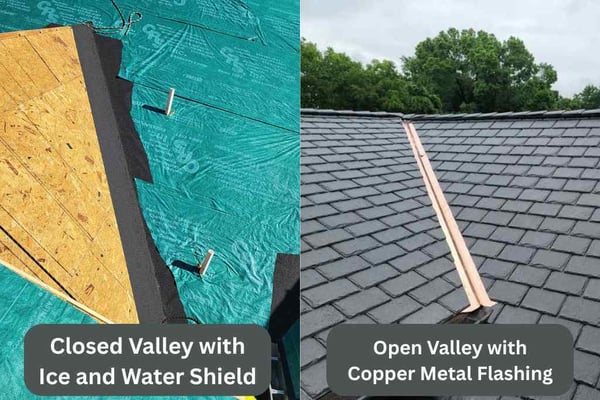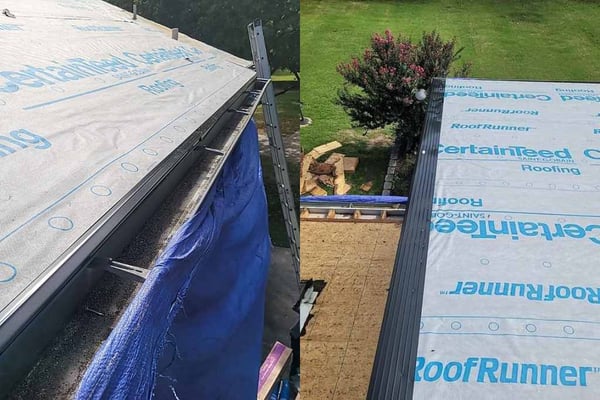Nashville, Tennessee | Roofing Industry Knowledge
9 Roofing Codes in Nashville, TN, You Need to Know

Need a new roof? Wondering what local Nashville building codes your roofer needs to follow to ensure everything is done correctly?
Getting a new roof in Nashville, TN, isn't cheap, so you’re expecting it to be installed correctly. Well, a huge part of proper installation is adhering to Tennessee building codes.
Unfortunately, some Nashville roofing contractors don’t follow rules or leave certain codes off the estimate to lower prices. This could lead to failing a home inspection, roof leaks, and can even shorten your roof’s lifespan.
For over 35 years, Bill Ragan Roofing has provided all Nashville homeowners the knowledge they need before investing in a roof replacement. So, let's look at the 9 roofing codes in Nashville, TN, you need to know.
Keep in mind, this is based on the 2018 International Residential Code, the standardized building code book.
1. Flashing (R903.2)
Roof flashing is metal installed to direct away from areas where shingles butt up against something, such as a wall. It's one of the most crucial roofing components and must be installed to prevent water from getting into your home through areas that are vulnerable to leaks.
According to code R903.2: Flashings shall be installed in a manner that prevents moisture from entering the wall and roof through joints in copings, through moisture permeable materials and at intersections with parapet walls and other penetrations through the roof plane. This code simply states that flashing must installed in areas that where water can enter through the roof.
So, if it’s damaged, rusted, or if you’re upgrading to a new shingle type or another roofing material completely when getting a new roof, it must be replaced per code. But if the roof flashing is installed correctly with no problems with the metal, you may be able to reuse it if the roofer is willing to stand behind the previous contractor’s flashing work.
2. Crickets and saddles (R903.2.2)
A roof cricket is a double triangle structure built behind a chimney to properly divert water around it. According to code R903.2.2: A cricket or saddle must be installed on the ridge side of any chimney or roof penetration more than 30 inches wide as measured perpendicular to the slope.
 (44 inch wide chimney that needs a cricket)
(44 inch wide chimney that needs a cricket)
The cricket or saddle coverings also shall be sheet metal or of the same roofing material as the roofing covering. This code ensures water coming down your roof has a way to get around a wide chimney or roof penetration.

Without a roof cricket, water pools behind your chimney on a surface that isn’t meant to have sitting water. This will ultimately lead to a leak and could be costly to repair the damage.
3. Roof covering application (R905.1)
Every shingle manufacturer has specific installation instructions your roofing contractor needs to follow to ensure your roof is properly installed. According to code R905.1: Roof coverings (roofing materials) shall be applied in accordance with applicable provisions of this section and the manufacturer’s installation instructions.
Not only is this a building code, but it's also the only way the manufacturer will honor your material warranty. So, this code simply means your local roofing contractor must follow all the installation instructions provided by the shingle manufacturer.
If your roofing materials aren’t installed properly, your roof isn’t up to code and it’ll void the roofing material warranty you get from the manufacturer.
4. Roof sheathing requirements (R905.2.1)
Roof decking or roof sheathing is the framing of your roof and what your roofing materials are installed on. According to code R905.2.1: Asphalt shingles shall be fastened to solidly sheathed decks.

(Redecking a roof before installing the new roof)
This code means that your roof decking (roof sheathing) must be able to withstand and hold your new roof when it’s installed. If there’s any rotten decking or if the decking can’t handle the new roofing materials, it must be replaced before your roof is installed.
Be aware, some roofing contractors lower their prices by skipping this to undercut the competition. When meeting with your roofing contractor, always ask them (if they haven’t done it already) to check your roof decking’s integrity.
5. Slope (R905.2.2)
The slope (or pitch) of your roof is the steepness calculated by the number of inches or feet it rises vertically for every 12 inches or feet it extends horizontally. For example, a roof that has a 4/12 pitch will be 4 inches (or feet) up for every 12 inches (feet) out.
According to code R905.2.2: Asphalt shingles shall be used only on roof slopes of 2 units vertical in 12 units horizontal (2:12) or greater. For roof slopes from 2:12 up to 4:12, double underlayment is required.
 (1:12 pitch that shouldn't have asphalt shingles installed)
(1:12 pitch that shouldn't have asphalt shingles installed)
This code means that if a roof has a pitch (slope) below 2:12, it’s not steep enough, per the shingle manufacturers or codes, to put shingles on it. If your roof’s slope is below a 2:12 pitch, it’s considered low slope and requires a membrane or metal roof system.
6. Ice barrier (R905.2.7.1)
Ice damming is when snow and ice freeze down by your gutter line (eaves), creating an ice blockage (dam). The thawed snow/ice will back up until the water gets underneath your roofing materials, which causes water to come through your ceiling and/or down your wall.
As ice damming becomes more common in Tennessee, codes are now in place to prevent roof leaks when we have a snow or ice storm.
According to code R905.2.7.1: In areas where there has been a history of ice forming along the eaves causing a backup of water, an ice barrier that consists of of at least 2 layers of underlayment cemented together or self-adhering polymer modified bitumen sheet (ice and water shield) that extends from the lowest edges of all roof surfaces to a point at least 24 inches inside the exterior wall line of the building.
.jpg?width=600&height=508&name=IceandWaterShieldUpgrade%20(2).jpg) (Ice and water shield on the rakes and eaves)
(Ice and water shield on the rakes and eaves)
This code means that if your roof has a history of ice damming, it needs a protective layer (ice and water shield) around the edges of your roof that goes 2 feet past the interior walls of your home. This code can only be applied when your old roof is torn off, and you’re starting from a clean deck.
7. Roof valleys (R905.2.8.2)
A roof valley is when two slopes of a roof meet. A roof valley is crucial to keep water flowing down your roof properly.
According to code 905.2.8.2: Valley linings shall be installed in accordance with the manufacturer's installation instructions before applying shingles.

Just like the roof covering application, this code means that the proper linings (per manufacturer installation instructions) have to be installed in your roof valleys before installing shingles. For open valleys (you can see the lining), it'll most likely be a metal.
For closed valleys (valley is covered with shingles), there should be underlayment or ice and water shield.
8. Drip edge (R905.2.8.5)
Drip edge is metal flashing that’s installed on a roof's edges (rakes and eaves) to protect the decking and prevent water from getting underneath the materials. It’s not only a crucial roofing component, but also one of the first things a home inspector looks for on a roof.
According to code R905.2.8.5: A drip edge shall be provided at eaves and gables of shingle roofs. Adjacent pieces of drip edge shall be overlapped a minimum of 2 inches. Drip edge shall extend a minimum of a ¼ of an inch below roof decking and extend up a minimum of 2 inches. Underlayment must be installed over the drip edge along the eaves and under the underlayment on gables.

This code means that drip edge must be installed (in accordance with the above specifications) on the edges of your roof. Just know that some roofing contractors leave off drip edge to lower their prices.
If this happens, your roof won’t be up to code and you'll have costly problems.
9. Reinstallation of roofing materials (R908.5)
When your roof is replaced, certain roofing materials might not need to be replaced. As long as the roofing material’s (roof flashing, roof vents, etc.) integrity and functionality aren’t affected, they can be reinstalled on your roof.
However, according to code R908.5: Existing slate, clay, or cement tile shall be permitted for reinstallation, except when damaged, cracked, or broken. Any existing flashings, edges, outlets, roof vents, or similar devices that are part of the assembly must be replaced when rusted, damaged, or deteriorated.
This code means that if any of your outer roofing materials or components are damaged or if they lose functionality, they have to be replaced during your roof replacement. This is especially important if you have a code upgrade policy or if your insurance claim needs to be supplemented.
Looking for a Nashville roofing company you can trust?
You just learned 9 roofing codes you need to know in Nashville, TN. Just remember that this is just a taste of the building codes set forth by the 2018 IRC.
Like I stated a couple of times in this article, some roofing contractors don’t follow these codes to bring their prices down. Whether it’s to beat out the competition’s prices or they’re just lazy, a lot of homeowners have been taken advantage of by these practices.
Some companies may want to run a business this way, but it's not how I operate.
For over 35 years, Bill Ragan Roofing has provided high-quality roofing services to homeowners in Nashville and surrounding Middle Tennessee areas. I trust our craftsmanship and believe in standing behind it, which is why I proudly offer a lifetime warranty.
Request a Quote Here or call our office at (615) 242-0333 today to schedule your free roof replacement quote.


